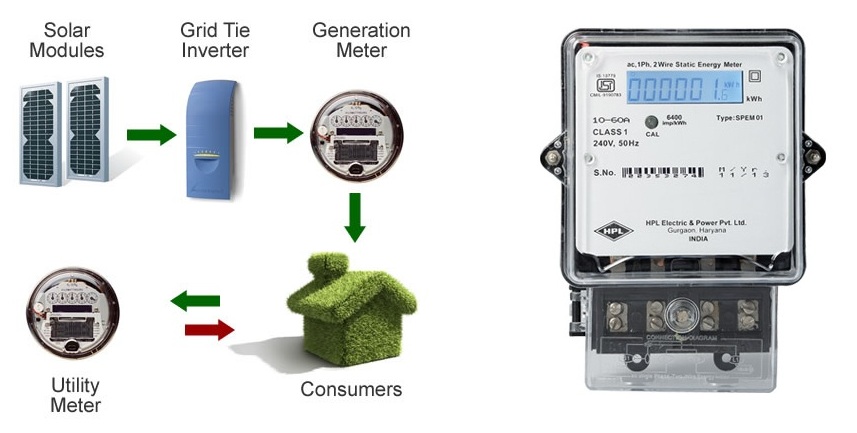Page Contents - Jump to:
What is Solar Net Metering and How it Works
In Solar Net Metering excess electricity is fed into our electric utility’s/electricity board when our On-Grid or Hybrid Solar Power Plant produces more than our need, in that case our meter runs in reverse direction. When our system is not producing enough electricity as per our load, then we can draw it from your utility just like ordinary meter. Solar panels produce peak electricity in the afternoon, when many people aren’t home in peak times may be in offices. In home electricity use is typically higher in the evenings and mornings, then net metering helps you to reduce electricity bill by using Import and export Facilities.

Working-Diagram-Of-Solar-Net-Meter-PRICEnMORE
The existing energy meter in our building or home will need to be replaced by a two-way (bidirectional) meter. This bidirectional energy meter or Net Meter is essential as it can measure both, energy import (from the grid to the Customer) and energy export (from the customer to the grid) separately.
Technical Specifications/Features of Solar Net-Meter:
• Pulse output LED's for kWh & kVArh.
• Separate readings for Active Energy.
• Net Energy kWh with sign.
• Single and Three phase
• Current Rating:-0-60 Amp
• Applicable Standards:-IS 13779:99
Price of Net Meter:-
Price of Net meter is depend upon the Electricity Board usually available at Rs 4050 only.


Procedure for Solar Net Metering
This is the standard flow chart for Solar Net Metering. Because, in every state there are different type of Electricity departments or power distribution companies. So procedure of Net Metering may differ as per your state.
• Application for installation of Rooftop Solar PV System: -Applicant shall tender an application to SDO with a processing fees of Rs 1000/- for seeking permission for installation of Rooftop Solar PV System
• Acknowledgement for receipt of application: - Acknowledgement of receipt of application shall be given by subdivision office to consumer on same day.
• Site Verification/Technical Feasibility: - Site verification shall be carried out by SDO (OP), within 3 working days from the receipt of application
• Approval for installation of Rooftop Solar PV System: - Approval shall be granted by SDO (OP) within 15 days from date of submission of application by consumer. System feasibility check shall be done within a week for 5 kWp above capacity plant, however same is not required for plant having capacity Up to 5 kWp.
• Signing of Net Metering Agreement with Nigam: - Agreement shall be signed by consumer and concerned SDO, within 3 days after submission duly filled agreement by the consumer
• Installation of Rooftop Solar PV System: - After approval of installation, consumer shall install Rooftop Solar PV System from companies/firms empanelled with MNRE. Installation of Solar Rooftop shall be done in 180 days from date of approval given by concerned SDO/OP.
• Submission of safety certificate by consumer: - For PV system up to 20 kWp installation certificate by empanelled agency is suffice. For PV system more than 20 kWp and up to 100 kWp, safety certificate issued by Charted Engineer shall be required. For PV system above 100 kWp Inspection of Electrical Inspector shall be required before commissioning.
• Work Completion Report:- Applicant shall submit the “work completion report” along with enclosures
• Commissioning of Rooftop Solar PV System:- Applicant may procured the meter from empanelled firm, if meter is not available in Nigam Store. Meter shall comply the specifications issued by Nigam. SDO (OP) and M&P team will connect the Rooftop Solar PV System with the Gird. After submission of work completion report and safety certificate by applicant, commissioning of system shall be done within 3 days.
Sample of Electricity Bill with Solar Net-Metering
This is the standard Electricity Bill with Solar Net Metering. Because, in every state there are different type of Electricity departments or power distribution companies. So rebates and method of calculation for Solar Net Metering bill may differ as per your state.

Sample of Electricity Bill with Solar Net Meter
Illustration: If a consumer in Gurgaon located in Haryana imports 2927 kWh(units) in April billing month and exports 2376 kWh(units) in the same month, the consumer will be billed for only 551 kWh. If the import energy in the March period is 1500 kWh and the export again is 1600kWh, then the excess 100kWh will be carried forward to the next month’s bill or next billing cycle and adjusted there as we can see in the pictures. At the end of the financial Period if Solar energy is produce more than the consume units then solar energy export shall be determined.
Top Solar Bands in India
Brands: TATA Solar, UTL Solar, LUMINOUS Solar, SUKAM Solar, HAVELLS Solar, PATANJALI Solar, EXIDE Solar, MICROTEK Solar, WAAREE Solar, VIKRAM Solar, JAKSON Solar, ADANI Solar, LUBI Solar, DELTA Inverter, ZEVER Inverter, SMA Inverter, GROWATT Inverter and SOLAX Inverter.









